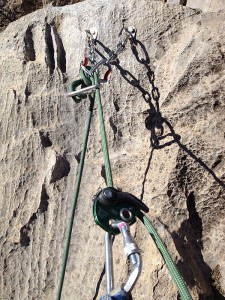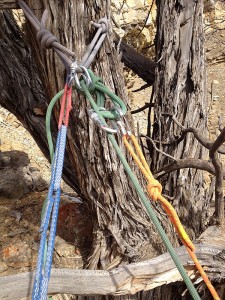Tech Tip – Rappelling with a GriGri (or Cinch or what have you)
By Mike Schneiter
Multi-pitch sport climbing, though somewhat rare in the US, is such a joy. I love the feeling of casting off on long pitches of beautiful face climbing, with nothing but a dozen quick draws bouncing off my harness. Forget the extra burden of cams, stoppers, cordalettes and related gear. And you can also forget that ancient belay and rappel device commonly referred to as an ATC.
Recently, on a multi-pitch sport outing, I collected the rope for our descent when my partner looked on perplexingly as I prepared for the rappel. “Forget that thing, grab your GriGri, we’re sport climbing.” Realizing he wasn’t familiar with how I was going to descend, here’s a little tech tip on how you can embrace your inner sport climbing mojo and apply your sport belaying and rappelling techniques to a wide variety of descents.
How To (click to enlarge photos)
 Run your rope through the anchor like you normally would. On the strand you aren’t going to rappel on, tie a Big F’ing Knot (BFK, it’s a technical term of course) such as a Figure 8, Yosemite 8, or Figure 9. The whole point here is you want a big knot that won’t pull through the rings or chain or whatever the rope is going through at the anchor. Clip the loop from the BFK into the side of the rope you are rappelling on with a locking carabiner.
Run your rope through the anchor like you normally would. On the strand you aren’t going to rappel on, tie a Big F’ing Knot (BFK, it’s a technical term of course) such as a Figure 8, Yosemite 8, or Figure 9. The whole point here is you want a big knot that won’t pull through the rings or chain or whatever the rope is going through at the anchor. Clip the loop from the BFK into the side of the rope you are rappelling on with a locking carabiner.
If you are rappelling on a single rope make sure both ends are touching the ground. You will pull the side of the rope that has the big knot in it. You will rappel on the other side. Good practice is always to fully weight your system after clipping your belay device into the rope and before unclipping yourself from the anchor. In this scenario, it is a good check that you are rappelling from the correct side of the rope and you have a good knot against the anchor that won’t pull through.
If you are rappelling a full rope length and are using a tag line to pull the rope do all of the above plus the following: Clip your tag line into the  same loop you’ve clipped into your rope. You can just tie a simple overhand into your tag line and clip it into the loop with a carabiner. After you rappel you will pull your tag line to retrieve your rope.
same loop you’ve clipped into your rope. You can just tie a simple overhand into your tag line and clip it into the loop with a carabiner. After you rappel you will pull your tag line to retrieve your rope.
When It Works
– You’re climbing multi-pitch with a GriGri, Cinch or similar device that only handles single ropes. It has become increasingly popular to climb multi-pitch routes with devices that have traditionally been reserved for sport climbing duty. I’ve talked to prominent guides who even advocate carrying multiple devices, such as the GriGri, for multiple clients because it makes many tasks easier, such as lowering, raising and a whole host of tricks. These devices have been getting lighter and hence, it makes more and more sense to use devices such as these for their ease of use.
– You want the ability to easily go hands free while rappelling in order to perform tasks such as freeing a stuck rope, cleaning a route, or because you need to swing into an anchor on an overhang. Maybe your climbing partner just tossed a mess of rope off the ledge with the same care a high schooler gives to their job in a fast food joint. You look below and see a snarl of rope stuck in cracks, wrapped around small trees and being pierced by cacti. Rather than back up your rappel you can cast off without worry, rappelling on your GriGri or device of choice.
– You’re climbing at your favorite sport destination and you decide to rappel because you want to do some cleaning on your project and your belayer is anxiously awaiting his chance to chat up that cute girl a few routes down wearing the Prana capris. Carrying an ATC or traditional belay device at a sport crag like Rifle is akin to showing up at an al Qaeda training camp with a yarmulke. Hence, all you’ve got is your beloved idiot proof belay device (read: sport climber belay device).
– You’re at the top of a climb with your brand new, shiny climbing rope looking down at a muddy mess at the base of the climb created by the spring conditions. There’s a ledge a few feet off the ground where you could finish and keep your fancy new cord all pretty and nice. Drop the rope to the point where you want to finish, safely above the muddy mire below and rappel away. Similarly, there are plenty of climbs where your rappel route looks like a scene from a car wreck and the threat of sticking a rope in a nasty crack or on some choss-filled ledge is a serious concern.
– When I am rope soloing, such as on TR laps, this tends to be my rappel method of choice. I’m usually just doing one or two pitch climbs and the pulls are usually easy. I like to keep things as simple as possible and I usually have enough on my harness already so carrying an ATC for rappelling is just something extra that will get in the way.
When It’s Not a Great Idea
– This rappel method works great for steep, sport pitches and rappel routes that are free of snags, but if there is a feature that could potentially snag your BFK then you’ll want to avoid this setup. Cracks, horns, and other protrusions that can interfere and stick a rope are what you want to watch out for, as you would on any rappel.
– Similarly, if the rappel anchor is situated so that you’re going to have to pull the rope over an edge or other obstacles it may make the rope difficult to pull. Savvy rope pullers may not be deterred by this, but others may take pause and choose a traditional rappel.
– You might think twice if there is something funky about your rappel anchor. I’ll leave that up to you to decide what that is. If you climb long enough you’re probably going to rappel off something weird and while this method doesn’t exert any extra force onto an anchor there is always the possibility that you’re rappelling off something different enough that maybe you don’t want to do this. So, this is basically my disclaimer to say, “I have no responsibility for your own safety, use your best judgment, if you set this up wrong you could get hurt or die!”
Mike Schneiter doesn’t only climb multi-pitch sport routes, but he loves how light your pack is when you do. He is the owner of Glenwood Climbing Guides.
5 Responses to Tech Tip – Rappelling with a GriGri (or Cinch or what have you)
Bulldog Creek Dog Walk (IV WI 4+)
Hayden Carpenter and Tom Bohanon recently repeated an obscure ice climb on the south side of Mt Sopris. Given a brief mention in Jack Robert’s ice guide, Bulldog Creek Walk is described as being 100 meters of WI 4. What they found was seven pitches of ice in a remote setting that makes for one […]
Connect with Us















If the station is equipped with rap rings, this is what I’ll tend to do. Run the rope through the rap rings and tie into the rope as normal. Attach the gri gri/cinch to the rope coming out of the other end of the rap rings. Pull out all the slack in the system so my weight is balanced between the tie in point, rap rings and gri gri/cinch. “lower” myself using the gri gri. No big knot to worry about and a super smooth rappel.
You’re right Marc, that method will totally work and there is no knot to worry about. The two issues encountered are: 1, your rope is running through the rings and placing wear on them. If you’re the guy replacing that stuff then maybe you don’t have a problem with it and I’ve certainly used your method countless times. But, at some areas people get pretty peeved about unnecessary wear on the anchors like that. 2, if you’re lowering over sharp edges or other terrain you put wear on your rope. Maybe that’s not that big of a concern but for some people it will be and in some scenarios it should be.
The whole point of the method I have described is that it is another method for traditional rappelling, where the rope isn’t moving while you descend. I know rappelling, that old thing that a lot of people still have to do to descend from a climb.
This is good information Mike. While I would prefer to not do this type of rappelling when at all possible I can see how some people would like it in certain situations. I think that for one, keeping a shiny new rope shiny is no cause for sacrificing safety. Two other issues with this method is that it is possible for the rapeller to attach to the wrong side of the rope without noticing (and possibly even load it slightly due to other matters) and then take a long, hard fall. climber must be very diligent. I have also seen a knot get jammed in the anchor when either pulling the wrong direction or when the weight of the climber is on it. Also rappelling with a grigri is not the only way to let go of the rope, the very old rap-around the leg method works great, just takes a little longer than letting go of a lever. I agree that Marc’s method is frowned upon in the majority of the climbing world as well. Just some other things for people to consider.
Great points Wayne, thanks!
A better alternative is to use an alpine smart for rappelling and get an almost foolproof “autolock”(not really autolock but for all intents and purposes it is) double rope rappel for free…
better, smoother and faster at paying out slack and is an “assisted” braking device.
The fundamentals are basically the same as with a grigri.
autolocks on a double rope rappel.
effortless at taking up slack when belaying in guide mode from the anchor.
half the cost of the grigri/cinch.
lighter than a cinch/grigri.
simple without any moving parts to worry about or wear down(well actually there are moving rollers that make lowering a bit smoother and easier on the rope)
The only detractor is that lowering takes a little bit of getting used to but once you get used to it, I think it’s better than lowering with an ATC. Grigri’s are ok to lower with for an experienced belayer but there have been too many accidents with people dropping with them.
I have a few ATC style devices and a Grigri and a partner that had a cinch and another partner that had a grigir… and everyone has converted over an loves it.
don’t get the cheaper single tube smart though… get the alpine smart.